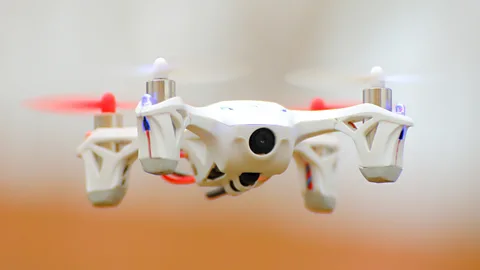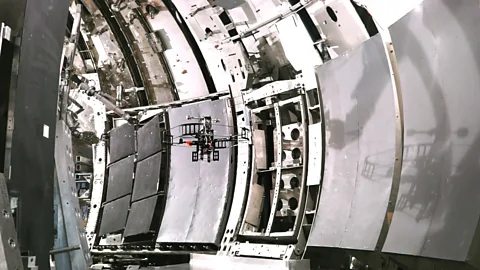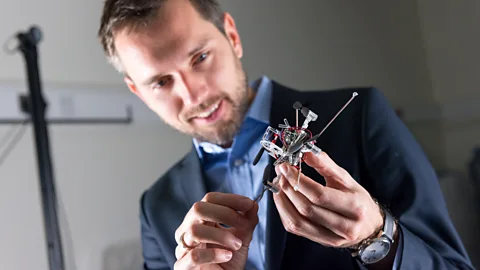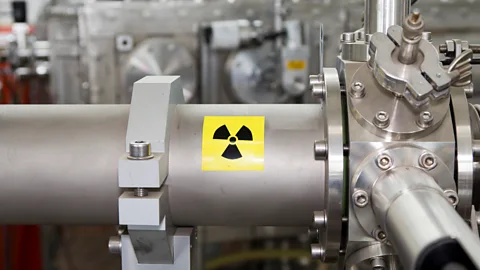The repair crew that can go where no human can
 iStock
iStockHow do you make repairs inside a nuclear reactor? The answer may be small drones that can fly and walk.
The robotic hand reaches out and touches the football-sized drone hovering inside the curved metallic walls of the unfinished doughnut shaped structure. Black and white panels cover some of the walls. In between, unexplained metal structures are left exposed waiting their turn.
This is a mock-up of the world’s largest operational – if still experimental – nuclear fusion reactor which looks like something off the set of Dr Who. The potential for drones and traditional robots to work together in the confines of a reactor had been turned from theory into practice, meaning that in the future they may be able to maintain reactors like this autonomously. No wonder the researchers are clapping and cheering; this could be history in the making.
The trial was the result of a collaboration between a team from UK Atomic Energy Authority’s Race (Remote Applications in Challenging Environments) and a team from Imperial College to together test the feasibility of using drones in the maintenance of the next generation of nuclear power reactors.
Commercial fusion reactors of the future will need to be able to run without the large number of people required to keep the experimental reactors of today working. It could even save lives: reactors of all kinds are dangerous places for the living because of the intense radiation they produce.
 Deniz Topcuoglu and Goshen Ongun
Deniz Topcuoglu and Goshen OngunThese drone trials are taking place 10 miles south of the dreaming spires of Oxford in a huge windowless building on a former military base that is now the Culham Centre for Fusion Energy (CCFE), the UK's national laboratory for fusion research.
Since the late 1970s Culham has been home to the Joint European Torus (Jet) experimental fusion power plant. Jet is itself a prototype designed to pave the way for bigger reactors that can be connected to the electricity grid. The much larger International Thermonuclear Experimental Reactor (Iter) experimental fusion reactor is already under construction in France, and the first commercial-sized Demonstration Power Station (Demo) is being planned, to expand on the results of Iter.
Nuclear power come with a hazardous reputation – but that is for the nuclear fission reactors currently in service. Nuclear fusion, instead, harnesses the power that gives light to the stars: it generates energy by fusing the nuclei of two atoms together rather than splitting atoms apart. This reaction is then contained, usually within a kind of magnetic forcefield inside the reactor. It takes a huge amount of energy to do this, and the challenge continues to be to produce more energy from the reaction than is used to create it.
Nuclear fusion has the potential – at some point in the future – to deliver limitless, cheap power without the dangerous nuclear waste of today’s reactors, thanks in part to the relatively low quantities of radioactive material required.
Besides the professional challenge of completing such a feat is the fact that the experimental fusion reactors built to date take a lot of time and manpower to keep them running. As larger and more advanced fusion reactors are constructed, the technologies needed to maintain them will have to evolve further if they are to become commercially viable.
We have been standing on a gantry outside a large vessel left over from the building of the reactor and added to over the years to allow the engineers to practice almost everything that might be needed in a real reactor. One of the two huge robotic arms usually used to maintain the reactor has been plugged into the side of the vessel.
This sophisticated two-armed system, which is already in use, allows operators to perform maintenance and upgrades without entering the reactor, such as when they had to replace all 7,000 tiles in the reactor wall. It has a monitoring system that allows the operators to see what it is up to in 360 degrees virtual reality without having to go into the reactor themselves and be exposed to a lethal dose of radiation.
 Aerial Robotics Lab, Imperial College London
Aerial Robotics Lab, Imperial College LondonAs we watch the demonstration, the pilot struggles to control his four-rotor drone, the AscTech Hummingbird, because of the turbulence created by its own rotors in such a small space. He cannot react in time to the minute changes of air pressure and wind direction, and the quadcopter drops, crashing into the wall and finally onto the floor.
The large AscTech Pelican drone, meanwhile, demonstrates the ability of drones to scan the walls of the reactor for faults.
Now it is the turn of the Nano aerial vehicle, another quadcopter, the size of the palm of a human hand and made out of transparent plastic and printed circuit material. It was built by a team from Imperial College London’s Aerial Robotics Laboratory to demonstrate the potential of bio-inspired technology – that is, technology that uses the key engineering principles from evolution.
The team drove the 60 miles from London to work with Race; it was the first opportunity to fly drones inside the hall of the Jet fusion reactor.
The Nano buzzes into the air like a mosquito, and, to conserve its battery, attaches itself with a magnet to the underside of a metal plate held by the robot. Then the drone uses a pulley and cord to lower itself down to the floor like a spider.
“Nuclear radiation can be very dangerous, so it is important that we develop robots that can go into places like this where humans can’t,” says Mirko Kovac, director of the Aerial Robotics Laboratory, who outlined his approach using bio-inspired technology in a recent paper in Science called “Learning from nature how to land aerial robots”.
“Today we have demonstrated that drones and robotic arms can work together to inspect structures and help each other,” he says. “We have also shown how drones can perch to save energy and then lower themselves down into difficult-to-get-to spaces or even crawl over the surface. However, it is the first time we have flown anywhere like this and it is a very challenging environment. It is a very small and confined space with complex geometry. Flying there can create a surprising amount of turbulence that can destabilise a drone when it is being flown remotely.”
“The ultimate goal is to fly inside the reactor,” says Rob Buckingham, director of the UKAEA and head of Race. “What this has shown is that the technology isn’t ready yet. What we need is full autonomy so that the drones can respond quicker to the turbulence than a human pilot can. If they crashed in the reactor they could damage the wall of the reactor and leave debris behind. But this might change if we get to use really small lightweight devices.”
 iStock
iStockWhat the drones could be used for now would be flying over the reactor and real-time 3D mapping of the radiation in the hall to work out where it was safe for humans to go. However, it is clear that it would be much harder for the drones to be given permission to do this than fly in the mock reactor.
“We are already looking at using autonomous robots for cleaning, inspecting and transporting materials at the European Spallation Source,” says Rob Skilton, lead on software and control at Race. “However, these are ground robots, which are more well-established. We hadn’t been thinking of using flying vehicles.”
In the end, Kovac thinks the nuclear industry is caught in a dilemma: “It is quite rightly a very conservative industry because the consequences of something going wrong can be too awful to contemplate. However, aerial robotics can help make the next generation of nuclear power a success by reducing risk and saving costs compared to maintenance tasks performed by humans.”
The next generation of drones that Kovac is already designing that can fly, climb and crawl could be the ones to deal with this dilemma.
Join 700,000+ Future fans by liking us on Facebook, or follow us on Twitter, Google+, LinkedIn and Instagram
If you liked this story, sign up for the weekly bbc.com features newsletter, called “If You Only Read 6 Things This Week”. A handpicked selection of stories from BBC Future, Earth, Culture, Capital, Travel and Autos, delivered to your inbox every Friday.
